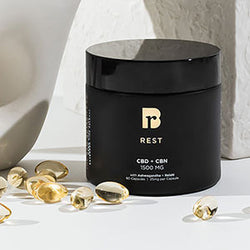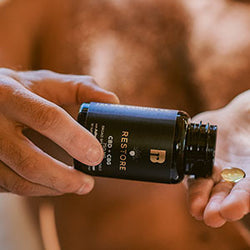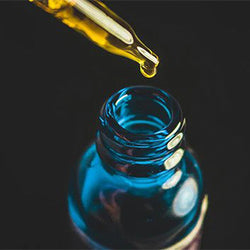What Are Cannabinoids?
THC, CBD, CBN, CBG, CBC, CBDA, CBDV. The abbreviations of some of the most important hemp products in the world are, in some ways, hilariously opaque. Perhaps because most of them sound like lesser spinoffs of the Congressional Budget Office, a lot of people who are interested in cannabis take one look at a blog like this, slip down a K-hole to a civics class spent watching a dreary C-SPAN debate, get leery or bored and click back out. But don’t click out. Stay in, because each of those blocks of lettering stand for different cannabinoids, the chemical compounds found in cannabis.
We’ve written before about terpenes, adaptogens, and functional mushrooms, all of which are blended into our CBD products, but exotic cannabinoids are the core active ingredients inside all our softgels, tinctures, relief creams, and everything else we sell. Plus, we find them to be a fascinating field of study. Here are a few facts about cannabinoids to whet your interest:
- Cannabinoids are compounds that naturally occur in the resinous glands of the cannabis sativa plant. (“Sativa” sounds like fancy horticulturalism, but it just means “things that are cultivated.”)
- Israeli researchers first isolated THC in pure form in the 1960s, although the isolation of CBN (cannabinol) dates back to the late 19th century.
- How many compounds are in cannabis? Up for debate, but most researchers peg that number at around 100–140.
- The major cannabinoids are tetrahydrocannabinol (THC) and cannabidiol (CBD). The minor cannabinoids include cannabinol (CBN), cannabigerol (CBG), cannabichromene (CBC), cannabidiolic acid (CBDA), and cannabidivarin (CBDV), among others. We’ll go over each one in this blog.
- When they’re ingested, cannabinoid molecules attach to cannabinoid receptors in our endocannabinoid systems. The effect they have on us depends on whether they attach to CB1 receptors (located in the brain and nervous system) or CB2 receptors (found on cells associated with the immune system).
Researchers have located these receptors throughout our bodies, from our gut to our spine and up into the neural HQ itself, the brain. Once activated, these receptors can affect your memory, appetite, temperature, fertility levels, and a host of other bodily processes. Read on for a rundown of each of the cannabinoids that we’ve listed—their medical applications, health benefits, and potential side effects.
What is THC (“Tetrahydrocannabinol”)?
Probably the most researched of the cannabinoids is THC, which has passed into the lexicon as a synonym for “marijuana,” although THC and marijuana are not exactly the same. Marijuana is the part or product of the cannabis plant that contains high doses of THC, which is the cannabinoid that produces the effects of marijuana on users. (Cannabis plants with high THC content are generally identified as marijuana. Cannabis plants with almost no THC content are referred to as hemp.)
Right now, marijuana is legal for recreational use in 19 US states and for medicinal purposes in 36 states. Research into THC is ongoing because, despite the intoxicating effects it has on users, it appears to be effective in mitigating pain.
What is CBD (“Cannabidiol”)?
CBD is typically the second most prevalent of the active ingredients in cannabis, after THC. Unlike THC, though, CBD is non-psychoactive, so you can enjoy its therapeutic effects while working or driving or watching TV in bed. (Without feeling like the sheets are frothy waves rising up to swallow you into the riptide.) CBD is also wildly popular—sales of CBD in the US are expected to crest $1.8 billion next year—and it comes in many forms. Coffee, edibles, candles, sandwiches, gummies, capsules, ice cream, vaporizer oils—the list goes on.
Since CBD tends to produce a calming effect, people often use it to assuage symptoms of anxiety. But studies have indicated that CBD might manage chronic pain, and treat seizures, depression, inflammation, sleep problems, panic disorders, vomiting and nausea, and eczema and acne—without producing the effects of intoxication that come with THC.
Other research has found that CBD might be able to treat neurodegenerative diseases and alleviate the pain associated with some cancer treatments. While CBD has a good safety profile, fair warning: Side effects may include exhaustion, diarrhea, and fluctuations in weight and appetite. Taken in a dose-dependent manner, CBD may increase the risk of liver damage when combined with certain medications (valproate, leflunomide, mipomersen, teriflunomide, among others). Ask your doctor about CBD before taking any supplements.
What is CBN (“Cannabinol”)?
Expose THC to heat and light for long enough, and it’ll break down into CBN—a non-intoxicating yet mildly psychoactive cannabinoid found in small amounts in cannabis. Studies suggest that CBN may have the potential to reduce pain and act as an antibacterial agent, and it’s garnered quite the reputation as a natural sedative. Other research has shown that it may increase appetite, delay the onset of certain neurodegenerative diseases, and stimulate the development of bone tissue, which might aid in osteoporosis treatments.
Scientists have not discovered any side effects associated with CBN, but that’s likely because further studies are needed to identify them. The FDA has not approved CBN to treat any conditions.
What is CBG (“Cannabigerol”)?
One reason that CBG is considered a minor cannabinoid is that most cannabis strains contain less than 1% CBG content. Yet CBG is also referred to as the “mother of all cannabinoids,”since it’s a parent molecule in cannabis from which many other cannabinoids are synthesized. CBG rivals CBD in popularity, and it’s known as a “brain” cannabinoid—whereas CBD is a “body” cannabinoid—because of how it increases dopamine levels and regulates mood and sleep patterns. Researchers also believe that CBG blocks serotonin receptors and limits GABA uptake in the brain, which may indicate that it can help treat anxiety and depression.
A study from 2020 reported that CBG and CBC showed anti-tumor properties in tests conducted on human gastrointestinal cancer cells. In a separate study, researchers determined that CBG helped stymie the evolution of colorectal cancer cells in mice. CBG may also aid in treating MRSA, glaucoma, bladder disorders, low appetite levels, nerve cell degeneration, and inflammatory bowel disease.
What is CBC (“Cannabichromene”)?
Studies have shown that CBC binds particularly well with two receptor sites (TRPV1, or vanilloid receptor 1; and TRPA1, or transient receptor potential ankyrin 1) that adjust our perception of pain. For that reason, CBC might serve as an all-natural alternative to prescription painkillers (which often produce adverse side effects).
CBC may also be a possible anti-cancer agent, and a study from 2013 investigated CBC’s role in forming adult neural stem progenitor cells (NSPCs), which the brain can transform into astroglial cells. Greater concentrations of astroglial cells may reduce the chance of developing neurodegenerative conditions such as Alzheimer’s.
What is CBDA (“Cannabidiolic Acid”)?
If you juice raw hemp plants that haven’t been exposed to too much heat and light, you can extract CBDA, which is something like the ur-CBD. (In part because once decarboxylation—a process that involves heating or smoking cannabis strains that are high in CBDA—removes all acid from CBDA, it transforms into CBD.) CBDA has been the subject of fewer scientific investigations than CBD, but it has been tested as a possible antiemetic and as a treatment for nausea and certain types of cancer.
What is CBDV (“Cannabidivarin”)?
Molecularly, CBDV is nearly identical to CBD, but studies have shown that it’s more applicable than CBD as a treatment for neurological disorders. Preliminary research on mice has led to hypotheses that CBDV might work as an anticonvulsant, helping reduce the length and severity of seizures in people diagnosed with Parkinson’s, epilepsy, or post-injury tremors.
In July 2020, the FDA approved Epidiolex, a drug that a British cannabis company, GW Pharmaceuticals, developed to treat seizures in rare genetic diseases. GW Pharmaceuticals has also conducted clinical trial studies into whether CBDV can help treat children with autism spectrum disorder (ASD). In addition, CBDV may provide relief from vomiting and nausea that result from chemotherapy.
The Raw Botanics Co. Cannabinoids - Shop CBD, CBG, CBN, CBC Products
In a previous blog, we discussed the benefits of the entourage effect—the process of blending terpenes, cannabinoids, and other cannabis compounds to produce a greater effect on a user than a single strain alone. We make all our products with the entourage effect in mind, mixing cannabinoids into a range of capsules and topicals and pillow mists, offered in full spectrum and broad spectrum varieties and arranged on our online shelf according to the benefits they provide—Rise, Relax, Rest, and Restore.
Read about our process of extracting the highest quality cannabinoids, and browse our shop to find out how our CBD, CBC, CBG, and CBN products can help you boost your energy, reduce your anxiety, improve your sleep, and relieve your pain the healthy way.







